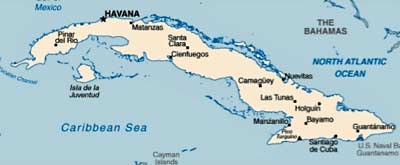
Map from the CIA World Fact Book
Cuba is a big place - the largest island in the Caribbean, it is roughly the size of Ohio. Just visiting Havana is like just visiting Cleveland. (Well, not really - Cleveland's population is but a sixth of Havana's 2.13 million - but you get the idea.)
Sure, there's much to see and do in Havana. It is, after all, the country's capital city, so you might want to visit the Capitol, or as it is in Spanish, el capitolio.
| |
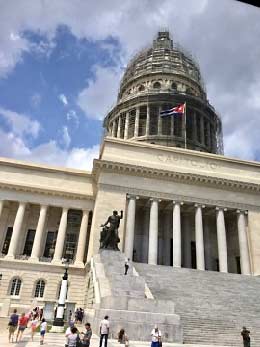 |
|
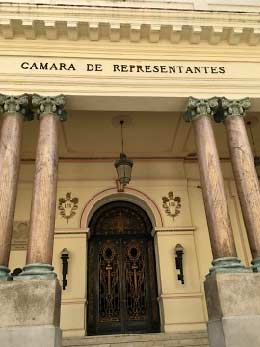 |
|
| |
Havana's El Capitolio |
|
Camara De Representates |
|
You can visit the Mueso Palacio de Gobierno which covers Cuban history from its liberation from Spain in 1902 through Fidel Castro's overthrow of Fulgencio Batista in 1959. It is in the home of the legislature that served over those years, El Camara de Representantes.
| |
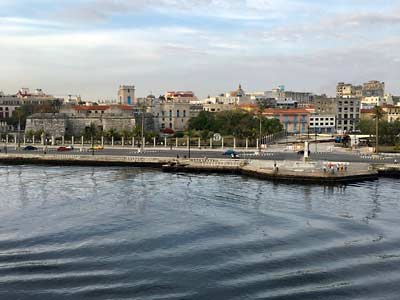 |
|
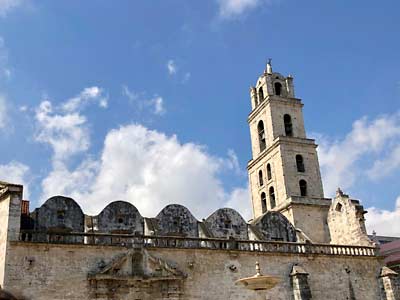 |
|
| |
Havana's Skyline Church |
|
Convent of Saint Francis of Assisi |
|
You can walk along the Malecón waterfront to view Havana's skyline, or visit its many gorgeous churches and cathedrals, including the church and convent of Saint Francis of Assisi - Iglesia y Convento de San Francisco de Asís.
Side Streets in Old Havana
Colorful buildings and colorful costumes
You might explore colorful side streets of Old Havana, or visit its markets and squares where citizens often don colorful clothing to pose for photos.
But there is so much more to Cuba, it would be a shame to confine yourself to this one city.
Take, for example, Santiago (or Santiago de Cuba as it is known to avoid confusion with the capital city of Chile).
The country's second largest city, with a population of nearly half a million, has a wonderful natural harbor. It has been guarded by the Castillo de San Pedro de la Roca, the massive fortress at the mouth of its very narrow entrance, since 1638.
| |
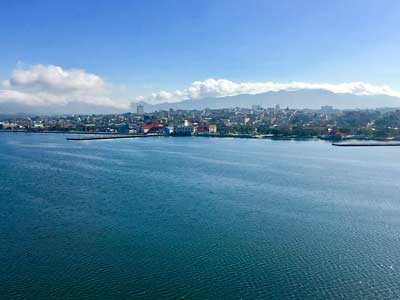 |
|
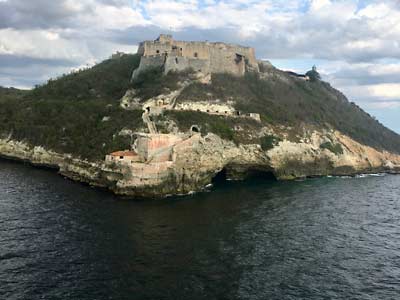 |
|
| |
Santiago de Cuba viewed from its harbor |
|
Castillo de San Pedro de la Roca |
|
The city's Parque Céspedes, named for Carlos Manuel de Céspedes, Cuban national hero, who in 1868, freed his slaves, declared Cuba independent of Spain and started the Ten Years' War, is flanked by the Town Hall on the northern side and the Cathedral of Our Lady of the Assumption (Catedral de Nuestra Señora de la Asunción) to the south.
| |
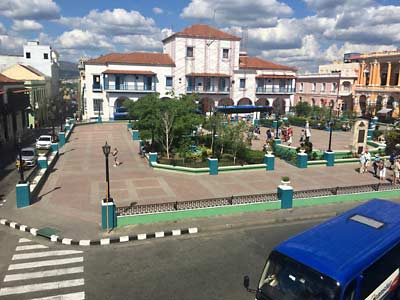 |
|
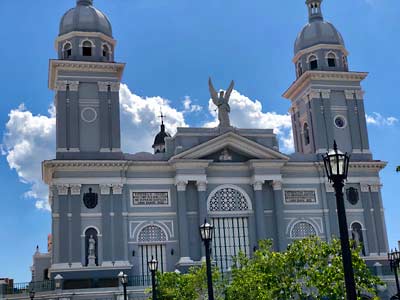 |
|
| |
Santiago's Town Hall (Auyntamiento de Santiago de Cuba) |
|
Catedral de Nuestra Señora de la Asunción
|
|
A drive toward the outskirts of town may take you past the Plaza de la Revolución with its huge equestrian statue of Cépedes' second in command, Antonio Maceo, by the contemporary artist Alberto Lescay. Across the plaza is the Teatro José María Heredia, a 2,452-seat theater and convention center named for the Cuban-born French poet.
| |
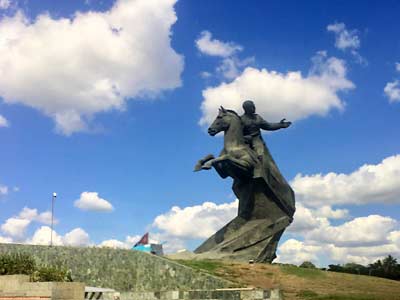 |
|
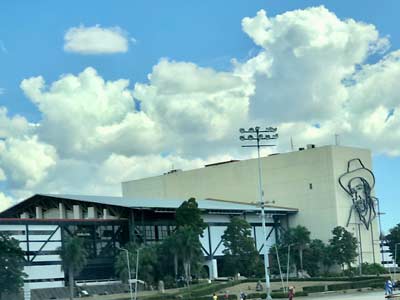 |
|
| |
Monument to Antonio Maceo |
|
Teatro Heredia |
|
Santiago de Cuba may interest American tourists because of the presence of San Juan Hill just outside its city limits. It is actually San Juan Heights, but the Yellow Journalists of William Randolph Hearst's New York Journal called it a hill when reporting on Teddy Roosevelt's charge with his Rough Riders during the Spanish-American War. Perhaps it is because the word Cuba isn't even in the name of that war—fought on Cuban soil over issues including Cuban independence—that tour guides and tour directories rarely speak of it. On our visit, we never heard the name Roosevelt mentioned.
But the city has a solid claim to another revolutionary moment—the start of Fidel Castro's rise. It began here on July 26, 1953, when he led an ill-fated attack on the Moncada Barracks. He and his followers failed to overthrow anything that day and he was captured and imprisoned. But there was no holding him or his movement down for long and within half a dozen years, his revolution had removed the government of Batista. Today, you can still see the bullet holes in the walls of the barracks.
| |
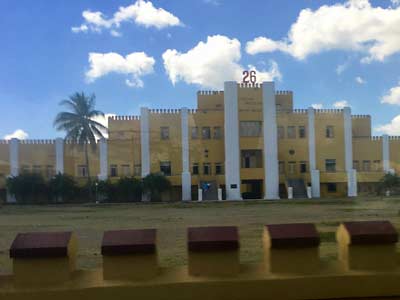 |
|
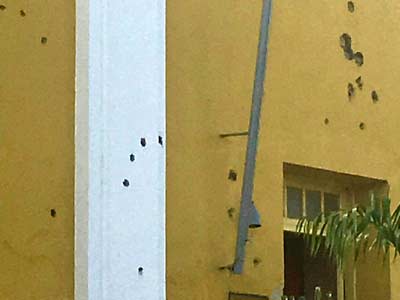 |
|
| |
The Moncada Barracks |
|
Remnants of Fidel Castro's Attack |
|
While you are in Santiago de Cuba, consider a side-trip to the impressive Basilica of Our Lady of Charity in nearby El Cobre. From its plaza you can also view the mining operations of the hills north and west of the city.
| |
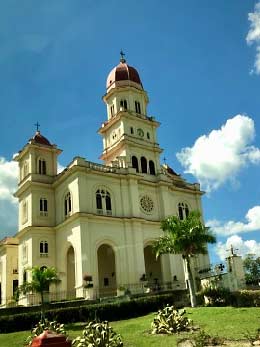 |
|
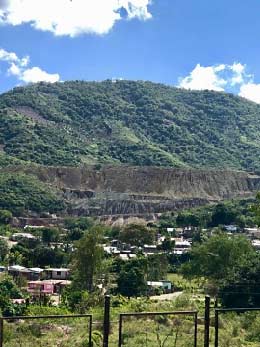 |
|
| |
Basilica of Our Lady of Charity (La Virgen de la Caridad) |
|
Mining Operations in the hills above El Cobre |
|
While Santiago de Cuba is on Cuba's southeastern-most coast, near the infamous Guantanamo Bay prison, the city of Cienfuegos (one hundred fires) is more centrally located on the south side of the island nation. It, too, has a grand natural bay with a narrow protected entry featuring eighteenth century fortifications, the Castillo de Jagua. Cienfuegos itself was established in 1819 by French and Spanish settlers to take full advantage of the bay as a harbor. The touch of French heritage gives the city an architectural feel closer to that of New Orleans, 500 miles to its northwest rather than that of Havana which is less than 150 miles away. The area has a long and rich history, having actually been one of the landfalls of Christopher Columbus during his second voyage to the new world in 1494.
| |
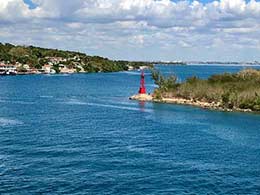 |
|
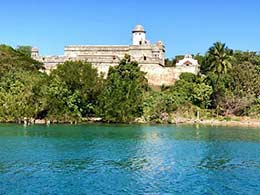 |
|
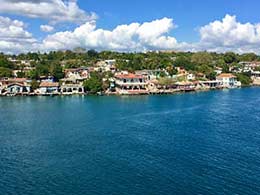 |
|
| |
Entrance to Cienfuegos Bay (Bahia de Cienfuegos) |
|
El Castillo de Jagua
|
|
A Fishing Village along the entrance to the bay |
|
The castle shares the shore of the entry to the bay with colorful fishing villages providing a great photo opportunity for passengers on cruise ships making their first landfall in Cuba. The captain of the ship we were on (The Viking Star) opened the bow deck so everyone could snap photos either from that deck or the observation deck above.
| |
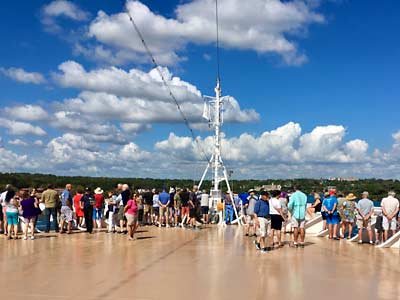 |
|
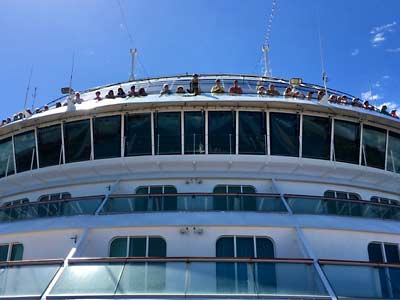 |
|
| |
Passengers snap photos from the bow deck |
|
Others snap theirs from the observation deck |
|
Once inside the bay and on land, the French influence became strikingly clear. Walking down the San Fernando pedestrian shopping street felt almost like walking down Bourbon Street in the French Quarter.
| |
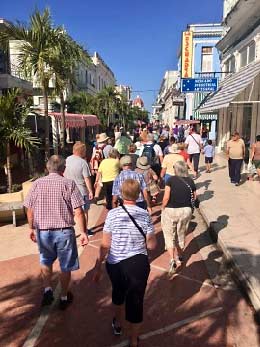 |
|
 |
|
| |
Pedestrians on Fernando Street, Cienfuegos |
|
The feel of New Orleans in Cienfuegos |
|
Along the way, however, there was one attraction not found in New Orleans - a cuban cigar store where tourists could watch cigars being rolled while they selected both tobacco and alcohol products to take home.
| |
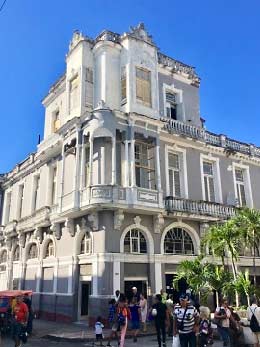 |
|
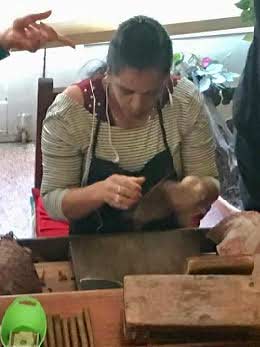 |
|
| |
Another French-inspired building hosts a cigar store |
|
A Cuban woman demonstrates cigar making |
|
San Fernando Street leads directly to Parque José Marti dominated by a statue of the leader of the Cuban Independence movement in the late nineteenth century.
| |
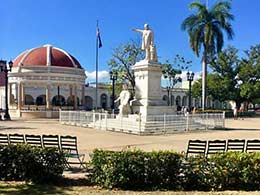 |
|
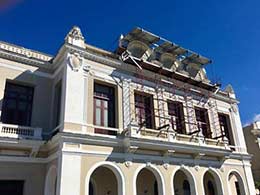 |
|
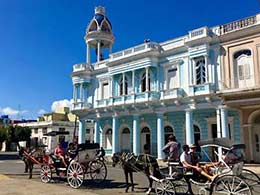 |
|
| |
José Marti Monument |
|
Teatro Tomas Terry |
|
Ferrer Palace |
|
Marti's statue stands to the side of the band shell where concerts are provided these days. But none can compare, one supposes, to the free concert that the legendary Enrico Caruso performed al fresco in 1920 at the Ferrer Palace. He sang from a balcony for the peasants who could not afford a seat in the nearby Thomas Terry Theater.
The free concert wasn't the most famous event of Caruso's visit to Cuba. That would have been the night he sang Verdi's Aida in Havana when a bomb forced the evacuation of the theater, putting Caruso on the street in full makeup and an Egyptian costume looking very much like a skirt. He was arrested for public indecency and held until the Italian ambassador arranged his release. Today, tourists in horse drawn carriages stop before the Ferrer Palace for portraits.
Also bordering the central square is the Museo Provincial and the Catedral de Nuestra Señora de la Purísima Concepción (Our Lady of the Immaculate Conception Cathedral). There has been a church here since 1833 which has often been expanded and renovated over the decades. It became a cathedral only in 1903 when Pope Leo XIII issued the apostolic brief "Actum praeclare." The museum is in a building built in 1893 as a Spanish casino with gambling on the ground floor and dancing on the second. Today it offers displays of Cuban art, design and local history.
| |
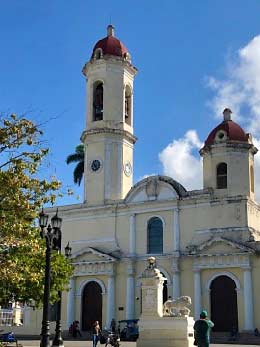 |
|
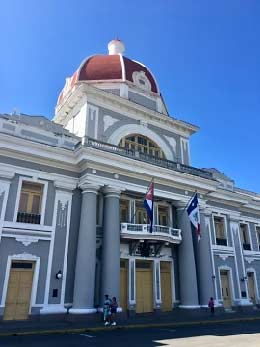 |
|
| |
Catedral de Nuestra Señora de la Purísima |
|
Concepción Museo Provincial
|
|
With its French influence, it shouldn't be a surprise, I suppose, that the square boasts its own or Arco de Triunfo or Arch of Triumph, the only such arch in Cuba. It is dedicated to Cuban workers (los obreros) and was constructed in 1902 with support from the bricklayers and longshoremen's guilds.
From the central square, a drive down this city's Malecón along the bay front takes you to the Bodega de Valle...the palace built by the Valle family in Spanish-Moorish style. Today, it is a restaurant, bar and favorite wedding site and some of the more modern public art finds display in front of the palace.
| |
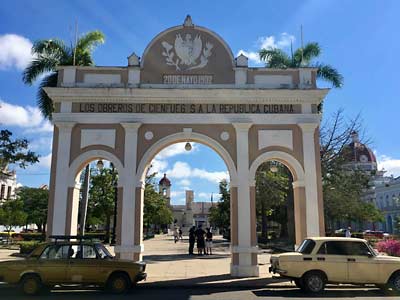 |
|
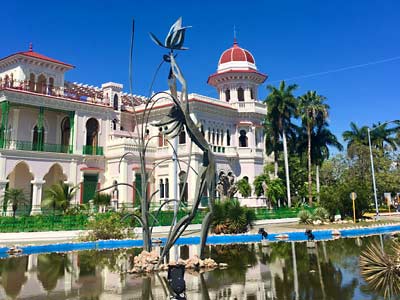 |
|
| |
Cuba's only Triumphal Arch |
|
Bodega de Valle |
|
Nearly forty miles down the coast from Cienfuegos, and a bit off the beaten track, is the old colonial town of Trinidad, a UNESCO heritage site.
Along the way from Cienfuegos to Trinidad, the road skims the rim of the Valle de los Ingenios where some 30,000 slaves used to raise sugar cain. While some sugar is still grown here, the old mills are mostly relics now—or tourist stops.
Here, under a thatched roof, a guide from the government-operated tour company demonstrated the operation of the mill.
| |
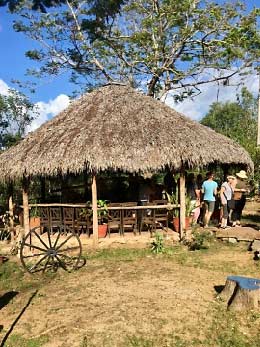 |
|
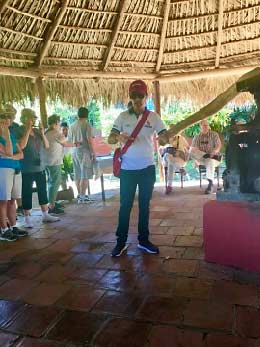 |
|
| |
A thatched roof protects a sugar mill's press |
|
A demonstration of the mill's sugar press |
|
In the town of Trinidad, there are sights to be seen, including the central square called The Plaza Mayor with the Church of the Holy Trinity (Iglesia Parroquial de la Santísima Trinidad) behind this statue of a self-possessed young lady and the Museo Romántico in a former colonial palace.
The streets are colorful and often lead to one of our favorite things - a restaurant that will serve cold cerveza on a shady veranda after a long afternoon in the sun.
| |
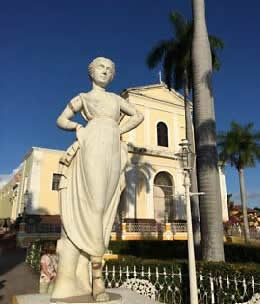 |
|
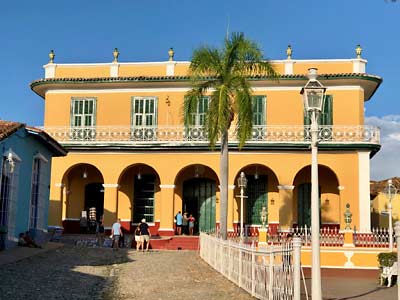 |
|
| |
Church of the Holy Trinity |
|
Museo Romántico |
|
| |
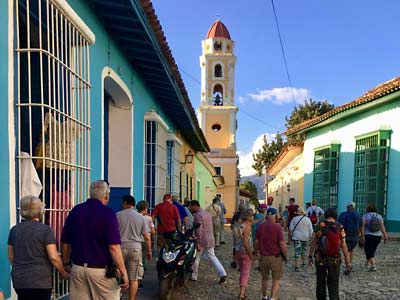 |
|
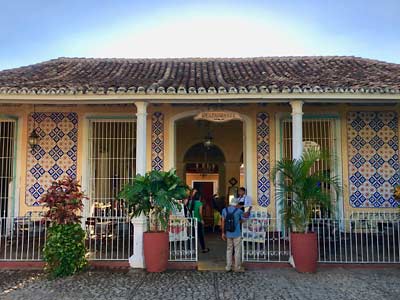 |
|
| |
Trinidad street scene |
|
Trinidad restaurant |
|
Of course, throughout Cuba it isn't necessary to walk too far while seeing the sights. This being Cuba, there are always classic cars to hire (or you can buy a model of one to take home from one of the stalls in the markets). Baring that - hire a carriage.
| |
Classic cars can be found throughout Cuba |
|
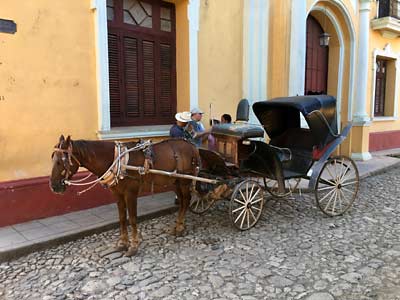
You can still ride the old way in Cuba
With any luck, you can return from a visit to Cuba with a stock of memories and a keepsake or two. For us, it was a ceramic sculpture of a typical building that could have been in Old Havana or Cienfuegos.
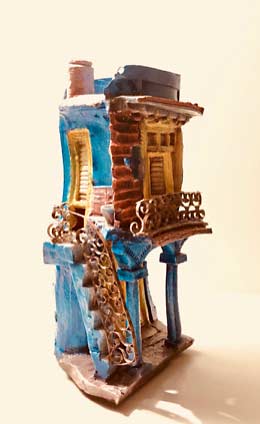
|